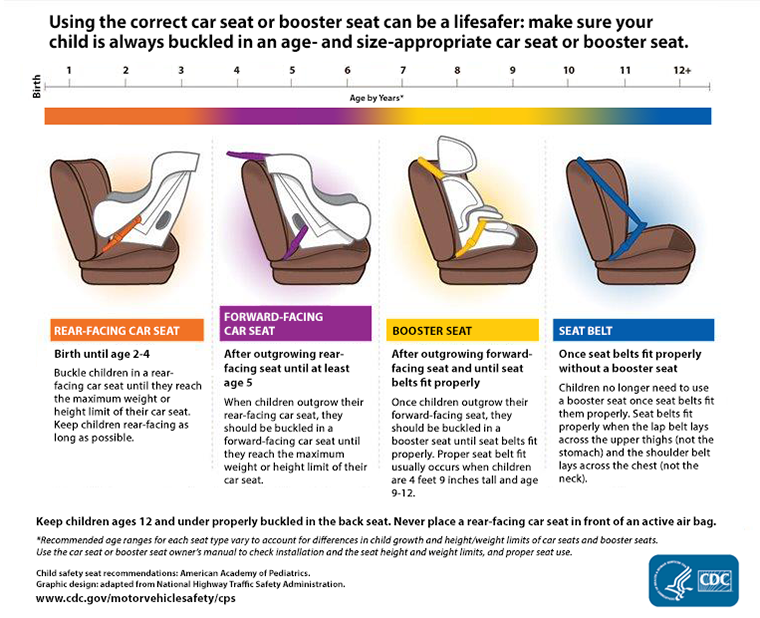 One of the most important investments you can make in your young child’s future is a car seat. Car crashes are the number one killer of children 1-12 years old in the United States. The best way to protect them in the car is to put them in the right seat and use it the right way. In a crash, a car seat spreads out the force of the crash evenly over your child’s fragile body and protects the head and spinal cord.
One of the most important investments you can make in your young child’s future is a car seat. Car crashes are the number one killer of children 1-12 years old in the United States. The best way to protect them in the car is to put them in the right seat and use it the right way. In a crash, a car seat spreads out the force of the crash evenly over your child’s fragile body and protects the head and spinal cord.
Select the correct car seat for your child based on child’s age and size as well as your particular vehicle.
If unclear about what is the appropriate seat for your child, please call the Comprehensive Children’s Injury Center at Cincinnati Children’s Hospital at 513-636-7865. For a list of fitting stations in the area visit www.cincinnatichildrens.org/ccic
- Ages 0-2: The American Academy of Pediatrics (AAP) recommends this child to be rear facing. There are different types of rear-facing seats such as infant-only seats (pumpkin seats) and convertible and 3-in-1 car seats. The convertible seat allows for typically higher height and weight limits so can be used rear facing and then may be turned front facing when appropriate.
- Ages 2-4: After the age of two, your child can ride in a forward facing car seat with a five point harness. He/she should remain in such a seat until they are four years old and weighs at least 40 pounds. The CDC recommends a rear facing car seat in some cases until the age of 4.
- Ages 4-8: Keep your child in a forward-facing car seat with a harness until he or she reaches the top height or weight limit allowed by your car seat’s manufacturer. Once your child outgrows the forward-facing car seat with a harness, transition to a booster seat, but the child should still remain in the back seat.
- Ages 8-12: Keep your child in a booster seat until they are big enough to fit in a seat belt properly. The recommended size is until they are 4’9”. For a seat belt to fit properly the lap belt must lie snugly across the upper thighs, not the stomach. The shoulder belt should lie snug across the shoulder and chest and not cross the neck or face
- REMEMBER: You child should ride in the back seat because it is safer there!
According to studies by the CDC, “In 2016, restraint use saved the lives of 328 children ages 4 years and younger” and that car/booster seats reduced the risk for injuries in crashes.
In order to have you child in the properly fitting car/booster seat, you must know the stages of progression between the various types of seats. Here is a chart from the CDC that shows the recommendations of the progression of car seats all the way up to using a seat belt…
Tips for restraining your child in the car seat (infant seats/rear-facing or forward-facing with harness)
- Place baby or child in the seat with the hips and back against the back of the seat.
- Position the shoulder straps so they are at or below shoulder level for infant seats or rear-facing and position the shoulder straps at or above the level of child’s shoulders if in forward facing with harness
- Make sure the shoulder straps are snug with no slack. You should not be able to pinch excess harness webbing together lengthwise at the top of the shoulders.
- Place the harness clip so it is in the middle of your child’s chest, at armpit or nipple level.
- Avoid thick layer of clothing under the harness
- Do not place blankets beneath or wrap blankets around your baby. You may place a blanket over them once the harness is fastened.
Tips for belt-positioning booster seats
- Make sure the lap belt is snug and positioned low enough to fit over the top of your child’s thighs.
- Check to be sure the shoulder belt stays on your child’s shoulder and lies flat across the chest
- Never put a shoulder belt under your child’s arm so it crosses over the lower chest or behind the back. This could cause serious injury.
State Laws for Car Seats
Along with knowing the proper progression of car/booster seats, you must know the law for the specific state that you reside in or are visiting. Here are the links to the laws for some of our surrounding states and some favorite vacation destinations…
- Kentucky: https://transportation.ky.gov/HighwaySafety/Pages/ChildPassengerSafetyInformation.aspx
- Ohio: https://ohio.gov/wps/portal/gov/site/residents/resources/car-seat-law
- Indiana: https://www.in.gov/isp/2897.htm
- Florida: https://www.flhsmv.gov/safety-center/child-safety/safety-belts-child-restraints/
- California: https://www.chp.ca.gov/programs-services/programs/child-safety-seats
With having what the CDC recommends and state laws, you must also keep in mind that every manufacturer has their own height and weight requirements for their specific seats. Let’s have safe travels this summer with the proper fitting car/booster seats!
Contact Us (859-525-8181) if you have any questions!
—
 About Pediatrics of Florence
About Pediatrics of Florence
We believe that children are more than just “little adults.” They have unique personalities, challenges, and life circumstances and we have made every effort to make our offices and care as “kid friendly” as possible. We have an aquatic theme in the waiting rooms (separated for sick and well children) as well as themed examination rooms. All of our physicians are Board Certified Pediatricians and members of the American Academy of Pediatrics and our nurse practitioners are all licensed Pediatric Nurse Practitioners and are available to see both well and sick children.
>> Learn More About Pediatrics of Florence

